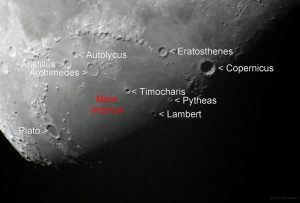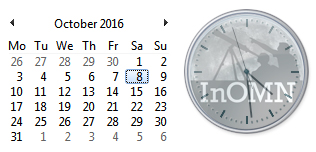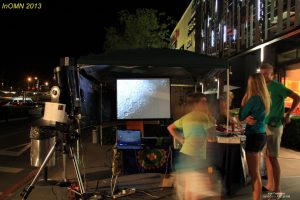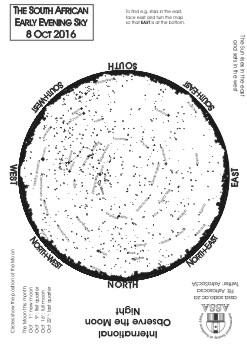
Join in the fun!
 International Observe the Moon Night (InOMN) is an annual worldwide public event that encourages observation, appreciation, and understanding of our Moon and its connection to planetary, lunar and exploration science.
International Observe the Moon Night (InOMN) is an annual worldwide public event that encourages observation, appreciation, and understanding of our Moon and its connection to planetary, lunar and exploration science.
Everyone is invited to join the celebration by hosting or attending an InOMN event — and uniting on one day each year to look at and learn about the Moon together.
InOMN is an ideal platform for astronomy related outreach and ASSA – via the Centres or as individuals – will be participating in the event on the 8th October 2016.
- Contact the ASSA Centres to find out their activities for InOMN
- Find an event near you
- Register your own event and send the details to [ outreach@assa.saao.ac.za ] to be included to the list of events below
Events across South Africa
No matter what you’re doing, there will be a live YouTube feed from ASSA observers across the country so you can follow the action at http://www.youtube.com/channel/UCJ4b1fhmPvYTOsy15YP-_JA/live
- Soutpansberg Astronomy Club: Makhado Crossing, Mike’s Kitchen, Louis Trichardt, Limpopo. Contact 079-148-4934, follow the live stream at https://youtu.be/An7zmEehhGA
- Star People: V&A Waterfront (Swing Bridge), Cape Town. Contact: 074-100-7237
- ASSA Johannesburg Centre: Johannesburg Observatory, 18 Gill St, Johannesburg. Contact: 072-985-8764
- Hermanus Astronomy Centre: Gearing’s Point, Hermanus
71 Marine Dr, Hermanus. Contact 081-212-9481 - Maboneng, Johannesburg:Fox Street, outside The Bioscope. Contact Claire 076-744-4735
- ASSA Pretoria Centre:Private observatory, Wierda Park, Centurion Contact 082-445-9343
- Add your event here! Send details to [ outreach@assa.saao.ac.za ].
What will I see?

With the naked eye the light and dark areas are the most obvious when looking at the Moon. The dark areas on the lunar surface are called mare, Latin for seas, which they are not. They are flattened plains of rock which at one time were molten. As well as being smooth the maria are low lying consisting of basalt lava. They appear dark because the basalt reflects little light. Maria are found exclusively on the near or Earth side of the Moon, covering 31% of the surface on the near side, compared with a few scattered patches on the far side covering only 2%. The largest being Mare Imbrium (Sea of Showers), which is visible during the First Quarter Moon.
The light or white areas are rugged mountains and highlands. Compacted rock and other material by many meteor strikes, crater rims and rays of ejected material look white because as the rock is pulverised by the impact, many small facets are created and these are highly reflected.
 With a small telescope, many of the 300,000 lunar craters that are over 1 kilometer in diameter wide are visible. The line separating sunlight from shadow is called the terminator. It takes some two weeks to move across the Moon’s visible surface. Through a telescope this movement can be seen in a few hours by carefully studying mountain peaks and the inside of craters. More detail is visible near the terminator than anywhere else. Many craters turn into white spots, or disappear from view entirely, when lit directly from above, as at Full Moon.
With a small telescope, many of the 300,000 lunar craters that are over 1 kilometer in diameter wide are visible. The line separating sunlight from shadow is called the terminator. It takes some two weeks to move across the Moon’s visible surface. Through a telescope this movement can be seen in a few hours by carefully studying mountain peaks and the inside of craters. More detail is visible near the terminator than anywhere else. Many craters turn into white spots, or disappear from view entirely, when lit directly from above, as at Full Moon.
When do I look?
 The Moon will rise at about noon, and sets around midnight and is thus visible in the afternoon and evening and is high overhead at sunset.
The Moon will rise at about noon, and sets around midnight and is thus visible in the afternoon and evening and is high overhead at sunset.
Save the date: October 08.
How do I look?
 If you’re stuck in a meeting, or if it is raining, you won’t see anything! If it is cloudy, you may still have a chance. But hopefully, the skies will be clear and the Moon will be shining brightly.
If you’re stuck in a meeting, or if it is raining, you won’t see anything! If it is cloudy, you may still have a chance. But hopefully, the skies will be clear and the Moon will be shining brightly.
No matter what you’re doing, there will be a live YouTube feed from ASSA observers across the country so you can follow the action. The link to the feed will be published soon.
Resources

- Download a star chart for October 08, perfect for printing at home
- Download a high-resolution map of the First Quarter Moon to help identify the most prominent craters and other lunar features
- Resources on the InOMN website
Sharing is Caring!

On Facebook: Share your photos on the ASSA Facebook page
On Twitter: Post your photo with the hashtag #observethemoon and tag @AstroSocSA in your tweet for a re-tweet.
Selected images will be featured in our live video feed and will be added to the ASSA image gallery on Flickr.
